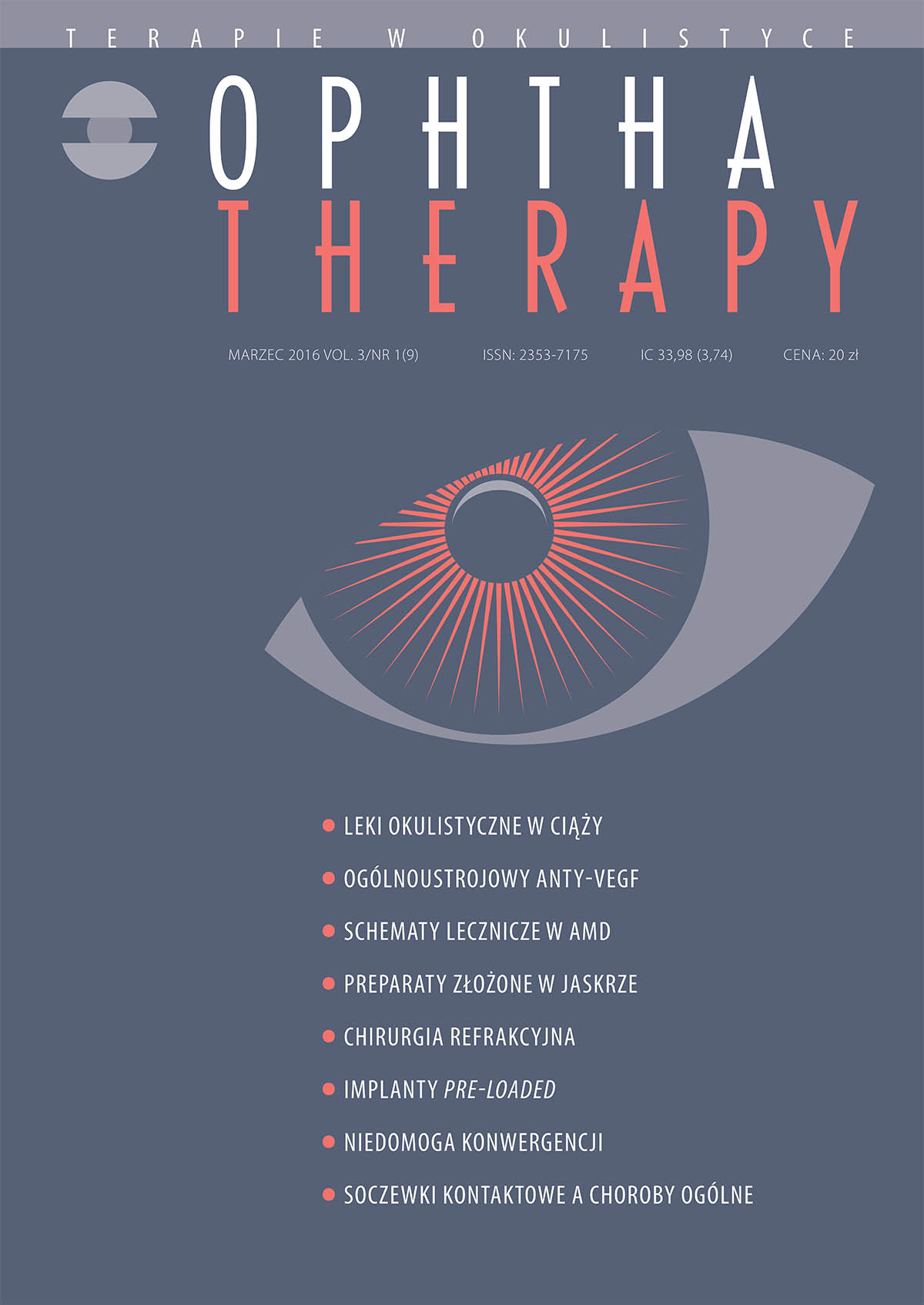Treating wet form of AMD – pros and cons
Main Article Content
Abstract
Anti-VEGF treatment is a gold standard in exudative AMD. Three drugs are currently used: ranibizumab (Lucentis), aflibercept (Eylea) and off- -label bevacizumab (Avastin). Different treatment regimen are used: fixed scheduled treatment, pro re nata and treat and extend.
Downloads
Download data is not yet available.
Article Details
How to Cite
1.
Święch-Zubilewicz A, Dolar-Szczasny J. Treating wet form of AMD – pros and cons. Ophthatherapy [Internet]. 2016Mar.31 [cited 2025Jul.13];3(1):32-6. Available from: https://journalsmededu.pl/index.php/ophthatherapy/article/view/590
Issue
Section
Articles

This work is licensed under a Creative Commons Attribution-NonCommercial-NoDerivatives 4.0 International License.
Copyright: © Medical Education sp. z o.o. License allowing third parties to copy and redistribute the material in any medium or format and to remix, transform, and build upon the material, provided the original work is properly cited and states its license.
Address reprint requests to: Medical Education, Marcin Kuźma (marcin.kuzma@mededu.pl)
References
1. Busbee BG, Ho AC, Brown DM et al. Twelve-month efficacy and safety of 0,5 mg or 2,0 mg ranibizumab in patients with subfoveal neovascular age-related macular degeneration. Ophthalmology. 2013; 120: 1046-56.
2. CATT Research Group, Martin DF, Maguire MG, Ying GS et al. Ranibizumab and bevacizumab for neovascular age-related macular degeneration. N Engl J Med. 2011; 364(20): 189.
3. Gupta OP, Shienbaum G, Patel AH et al. A treat and extend regimen using ranibizumab for neovascular age related macular degeneration clinical and economic impact. Ophthalmology. 2010; 117: 2134-40.
4. Holz FG, Amoaku W, Donate J et al. Safety and Efficacy of a Flexible Dosing Regimen of Ranibizumab in Neovascular Age-Related Macular Degeneration: The SUSTAIN Study. Ophthalmology. 2011; 118: 663-71.
5. Klein R, Klein BE, Tomany SC et al. Ten-year incidence of age-related maculopathy and smoking and drinking: The Beaver Dam Eye Study. Am J Epidemiol. 2002; 156: 589-98.
6. Lalwani GA, Rosenfeld PJ, Fung AE et al. A variable-dosing regimen with intravitreal ranibizumab for neovascular age-related macular degeneration: year 2 of the PrONTO Study. Am J Ophthalmol. 2009; 148(1): 43-58.
7. Larsen M, Schmidt-Erfurth U, Lanzetta P et al. Verterporfin plus Ranibizumab for Choroidal Neovascularisation in Age-Related Macular Degeneration. Twelve-month MONT BLANC Study Results. Ophthalmology. 2012; 119(5): 992-1000.
8. Martin DF, Maguire MG, Fine SL et al. Ranibizumab and bevacizumab for treatment of neovascular age related macular degeneration: two-year results. Ophthalmology. 2012; 119: 1388-98.
9. Muether PS, Hermann MM, Viebahn U et al. Vascular endothelial growth factor in patients with exudative age related macular degeneration treated with ranibizumab. Ophthalmology. 2012; 119: 2082-6.
10. Pascolini JD, Mariott SP. Global estimates of visual impairment: 2010. Br J Ophthalmol. 2012; 96(5): 614-8.
11. Richard G, Monés J, Wolf S et al. Scheduled versus Pro Re Nata Dosing in the VIEW Trials. Ophthalmology. 2015; 122: 2497-503.
12. Rosenfeld PJ, Brown DM, Heier JS et al. Ranibizumab for neovascular age-related macular degeneration. N Engl J Med. 2006; 355: 1419-31.
13. Schmidt-Erfurth U, Kaiser PK, Korobelnik JF et al. Intravitreal aflibercept injection for neovascular age-related macular degeneration: ninety-six-week results of the VIEW studies. Ophthalmology. 2014; 121: 192-201.
14. Wong TI, Li X, Su X et al. The Number and Distribution of People with Age-Related Macular Degeneration Worldwide. ARVO. 2013: 220-00065.
15. Wykoff CC, Croft DE, Brown DM et al. Prospective Trial of Treat-and Extend versus Monthly Dosing for Neovascular Age-Related Macular Degeneration. Ophthalmology. 2015; 122: 2514-22.
2. CATT Research Group, Martin DF, Maguire MG, Ying GS et al. Ranibizumab and bevacizumab for neovascular age-related macular degeneration. N Engl J Med. 2011; 364(20): 189.
3. Gupta OP, Shienbaum G, Patel AH et al. A treat and extend regimen using ranibizumab for neovascular age related macular degeneration clinical and economic impact. Ophthalmology. 2010; 117: 2134-40.
4. Holz FG, Amoaku W, Donate J et al. Safety and Efficacy of a Flexible Dosing Regimen of Ranibizumab in Neovascular Age-Related Macular Degeneration: The SUSTAIN Study. Ophthalmology. 2011; 118: 663-71.
5. Klein R, Klein BE, Tomany SC et al. Ten-year incidence of age-related maculopathy and smoking and drinking: The Beaver Dam Eye Study. Am J Epidemiol. 2002; 156: 589-98.
6. Lalwani GA, Rosenfeld PJ, Fung AE et al. A variable-dosing regimen with intravitreal ranibizumab for neovascular age-related macular degeneration: year 2 of the PrONTO Study. Am J Ophthalmol. 2009; 148(1): 43-58.
7. Larsen M, Schmidt-Erfurth U, Lanzetta P et al. Verterporfin plus Ranibizumab for Choroidal Neovascularisation in Age-Related Macular Degeneration. Twelve-month MONT BLANC Study Results. Ophthalmology. 2012; 119(5): 992-1000.
8. Martin DF, Maguire MG, Fine SL et al. Ranibizumab and bevacizumab for treatment of neovascular age related macular degeneration: two-year results. Ophthalmology. 2012; 119: 1388-98.
9. Muether PS, Hermann MM, Viebahn U et al. Vascular endothelial growth factor in patients with exudative age related macular degeneration treated with ranibizumab. Ophthalmology. 2012; 119: 2082-6.
10. Pascolini JD, Mariott SP. Global estimates of visual impairment: 2010. Br J Ophthalmol. 2012; 96(5): 614-8.
11. Richard G, Monés J, Wolf S et al. Scheduled versus Pro Re Nata Dosing in the VIEW Trials. Ophthalmology. 2015; 122: 2497-503.
12. Rosenfeld PJ, Brown DM, Heier JS et al. Ranibizumab for neovascular age-related macular degeneration. N Engl J Med. 2006; 355: 1419-31.
13. Schmidt-Erfurth U, Kaiser PK, Korobelnik JF et al. Intravitreal aflibercept injection for neovascular age-related macular degeneration: ninety-six-week results of the VIEW studies. Ophthalmology. 2014; 121: 192-201.
14. Wong TI, Li X, Su X et al. The Number and Distribution of People with Age-Related Macular Degeneration Worldwide. ARVO. 2013: 220-00065.
15. Wykoff CC, Croft DE, Brown DM et al. Prospective Trial of Treat-and Extend versus Monthly Dosing for Neovascular Age-Related Macular Degeneration. Ophthalmology. 2015; 122: 2514-22.

